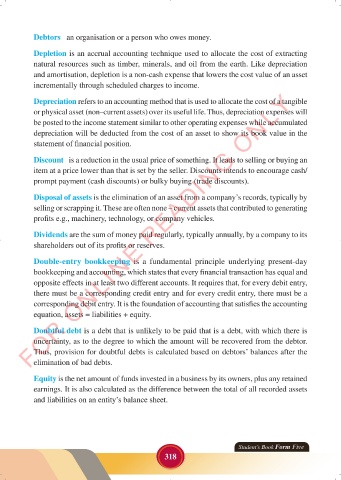Page 331 - Accountancy_F5
P. 331
Debtors an organisation or a person who owes money.
Depletion is an accrual accounting technique used to allocate the cost of extracting
natural resources such as timber, minerals, and oil from the earth. Like depreciation
and amortisation, depletion is a non-cash expense that lowers the cost value of an asset
incrementally through scheduled charges to income.
FOR ONLINE READING ONLY
Depreciation refers to an accounting method that is used to allocate the cost of a tangible
or physical asset (non–current assets) over its useful life. Thus, depreciation expenses will
be posted to the income statement similar to other operating expenses while accumulated
depreciation will be deducted from the cost of an asset to show its book value in the
LANGUAGE EDITING
statement of financial position.
Discount is a reduction in the usual price of something. It leads to selling or buying an
item at a price lower than that is set by the seller. Discounts intends to encourage cash/
prompt payment (cash discounts) or bulky buying (trade discounts).
Disposal of assets is the elimination of an asset from a company’s records, typically by
selling or scrapping it. These are often none – current assets that contributed to generating
profits e.g., machinery, technology, or company vehicles.
Dividends are the sum of money paid regularly, typically annually, by a company to its
shareholders out of its profits or reserves.
Double-entry bookkeeping is a fundamental principle underlying present-day
bookkeeping and accounting, which states that every financial transaction has equal and
opposite effects in at least two different accounts. It requires that, for every debit entry,
there must be a corresponding credit entry and for every credit entry, there must be a
corresponding debit entry. It is the foundation of accounting that satisfies the accounting
equation, assets = liabilities + equity.
Doubtful debt is a debt that is unlikely to be paid that is a debt, with which there is
uncertainty, as to the degree to which the amount will be recovered from the debtor.
Thus, provision for doubtful debts is calculated based on debtors’ balances after the
elimination of bad debts.
Equity is the net amount of funds invested in a business by its owners, plus any retained
earnings. It is also calculated as the difference between the total of all recorded assets
and liabilities on an entity’s balance sheet.
Student’s Book Form Five
318
23/06/2024 17:36
ACCOUNTANCY_DUMMY_23 JUNE.indd 318
ACCOUNTANCY_DUMMY_23 JUNE.indd 318 23/06/2024 17:36

